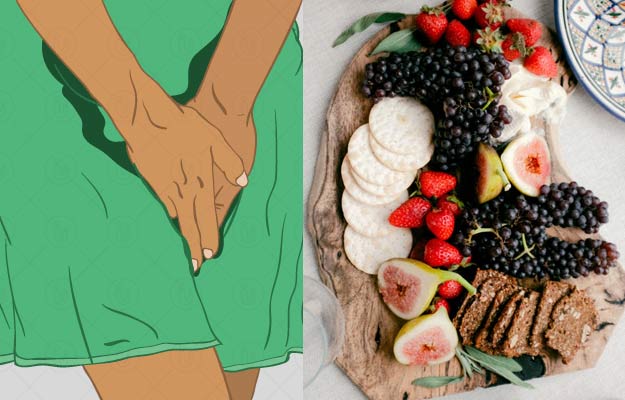Vaginal yeast infections are some of the most common problems in women. It is a type of fungal infection that occurs due to a disruption in the microbial flora of the vaginal area. These infections are usually characterised by abnormal vaginal discharge and itching in and around the vagina.
More frequently than not, a fungal infection in vagina is caused due to abnormal growth of Candida albicans, a yeast that makes the natural flora of vagina. Candidiasis equally affects women of all ages, and about 75% of women experience candidiasis at least once in their lifetime. If left untreated, candidiasis can lead to other vaginal conditions like leucorrhoea. Hormonal therapies, certain antibiotics and HIV are some of the factors that increase the risk of candidiasis.
In Ayurvedic texts, candidiasis and other female reproductive conditions are listed under yoni vyapat (diseases affecting the vagina). Panchakarma (five therapies) methods of snehana (oleation), abhyanga (oil massage) along with local treatments of pichu (medicated tampons) are used for the treatment of vaginal yeast infections. Antifungal herbs such as manjishtha (Indian madder) and daruharidra (Indian beriberi) are beneficial in suppressing the growth of vaginal yeasts.
Ashtanga hridaya, one of the major ayurvedic texts, mentions some dietary recommendations like inclusion of yava (barley), taila (oil) and pippali (long pepper) in the daily diet to promote recovery in vaginal yeast infections. Maintaining local hygiene further helps in preventing and managing vaginal infections.
- Ayurvedic view of vaginal yeast infections
- Ayurvedic treatment for vaginal yeast infections
- Ayurvedic herbs and medicines for vaginal yeast infections
- Dietary and lifestyle changes for vaginal yeast infection patient as per ayurveda
- How effective are ayurvedic medicines and treatments for vaginal yeast infections
- Side effects and risks of ayurvedic medicine and treatments for vaginal yeast infections
- Takeaway
Ayurvedic view of vaginal yeast infections
Symptoms of vaginal yeast infections like candidiasis are considered to be kapha pradhana or kapha predominant in Ayurveda. Eating kapha-increasing foods and following a lifestyle regimen that produces excess kapha in the body affects the yoni (vagina) and causes symptoms like kandu (itching) sheetalata (coldness), alpavedana (low-grade pain) and pichhilata (mucoid secretions) of the yoni. Candida infections also cause an excess amount of vaginal discharge or shwetapradara (leucorrhoea) in women.
Improper dietary habits like eating junk food, adhyashana (eating food in excess amounts) and viruddhahara (incompatible food combinations) are some of the causative factors of yoni vyapat. These habits vitiate doshas, leading to various conditions of the female reproductive system. Using foreign substances during sexual intercourse, excessive sexual activity, oral contraceptives and lack of hygeine can also lead to vaginal yeast infections and other vaginal problems.
Ayurvedic treatment for yoni vyapat comprises vata-pacifying therapies like snehana, swedana and abhyanga. Along with these therapies, mridu shodhana (purification using mild drugs) is also performed.
Asrigdara (menorrhagia), arsha (haemorrhoids) and gulma (growth or enlargement in the pelvic or abdominal area) are some of the complications of yoni vyapat.
Ayurvedic treatment for vaginal yeast infections
- Snehana
- Snehana procedure involves internal and external lubrication of the body for expulsion of imbalanced doshas.
- This therapy is performed as a single treatment procedure or as a pre-panchakarma procedure.
- In this procedure, oil or ghee (clarified butter) can either be administered orally or through the nasal route. Snehana can also be done by topical application of oils or administering oils in the form of an enema.
- Oils or fats used in snehana may be obtained from animal or vegetable sources, e.g., butter, fish oils, animal fat, milk or bone marrow.
- Abhyanga
- Abhyanga is a form of external oleation, in which, medicated oils are massaged all over the body.
- Abhaynga has a rejuvenating effect on the body. It reduces stiffness and heaviness and improves blood circulation.
- This therapy also improves musculoskeletal function and enhances nerve conduction process.
- Abhyanga promotes antibody production, thereby increasing your natural resistance against infections and diseases.
- Swedana
- In swedana therapy, sweating is induced using a variety of methods for alleviating stiffness, coldness and heaviness in the body.
- Sweating liquefies accumulated toxins in body tissues facilitating easier removal of ama.
- Swedana is mostly performed after snehana karma.
- Bashpa sweda (swedana using a steam chamber), valuka sweda (swedana using heated sand), parisheka sweda (swedana by pouring warm medicated oils on the body) and avagaha sweda (swedana by inducing sweating via immersion in hot liquids) are some of the common procedures used to induce sweating.
- Pichu
- Pichu therapy involves application of medicated oils to the affected area by using a cotton pad.
- For treating vaginal conditions, a medicated tampon-shaped cotton pichu is inserted into the vagina.
- Pichu prepared using nimba (neem) taila, karanja (Indian beech) taila, padmakadi taila, sarsapa (mustard) taila or shatadhauta ghrita is useful for reducing vaginal itching.
- A pichu using dhatakyadi taila is given to women diagnosed with leucorrhoea.
Ayurvedic herbs and medicines for vaginal yeast infections
Ayurvedic herbs for vaginal yeast infection
- Nimba
- Nimba is a bitter-tasting herb with astringent, antiviral and antiseptic properties.
- This herb acts on the circulatory, respiratory, digestive and urinary systems.
- Nimba is beneficial in the treatment of jaundice, rheumatism, malaria, leucorrhoea, fever, cough, and conditions like eczema and syphilis. It is also useful in treating dental conditions.
- Being an antibacterial and antifungal herb, it is effective in suppressing the growth of harmful bacteria and yeast and in vagina.
- You can take neem in the form of an infusion, oil, decoction, medicated ghee or as per your physician’s direction.
- Manjishtha
- Manjishtha is mainly used for treating problems related to circulatory and female reproductive systems.
- It is known to be one of the best blood-purifying herbs, which also helps control bleeding and improves blood circulation.
- Manjistha exhibits antitumour properties and it is a natural astringent.
- This herb provides relief from many health conditions like dysentery, hepatitis, paralysis, traumatic injuries, herpes, rheumatoid arthritis, heart diseases and dysmenorrhea.
- Manjishtha leaves have antimicrobial properties that make it useful in the treatment of infections like candidiasis.
- You can take manjishtha in the form of ghee, decoction, paste, powder or as per your physician’s direction.
- Daruharidra
- Daruharidra acts on the digestive and circulatory systems.
- This herb regulates liver function and reduces fat, blood pressure and toxin levels in body.
- Daruharidra has fever-reducing and tonic properties that make it useful in treating gastric ulcers, jaundice, skin conditions, diabetes, brain disorders, neuralgia and abdominal congestion.
- It contains active antimicrobial compounds, which are helpful in inhibiting the growth of yeasts in vagina.
- You can take daruharidra in the form of a paste, decoction, medicated ghee, powder or as per your physician’s direction.
- Brahmi (water hyssop)
- Brahmi is known as the best rejuvenating herb in Ayurveda. As a brain tonic, it improves intelligence and enhances brain cell function.
- It helps improve the function of respiratory, nervous, circulatory and reproductive systems.
- This herb is used to treat convulsions, memory loss, venereal conditions, bowel disorders, psoriasis and rheumatism.
- Brahmi improves immunity and prevents the growth of harmful bacteria and yeast
- It has been found to be effective in suppressing the growth of C. albicans; therefore, it is beneficial for candidiasis treatment.
- You can take brahmi in the form of ghee, infusion, oil, decoction, powder or as per your physician’s direction.
- Nagavalli (betel leaf)
- Nagavalli is a tikshna (incisive), vishada (clear), sara (flowing) and laghu (light) herb, which is known for its shleshmahara (phlegm reducing) and vatahara (vata reducing) properties.
- It also helps in reducing malodour and sourness in mouth.
- Betel leaf provides relief from kandu (itching), one of the most common symptoms of vaginal yeast infections.
- Betel leaves are also beneficial in treating agnimandya (weakened digestive fire) and jwara (fever).
- Seeds, leaves and alkaloids obtained from betel plant have antifungal activities that are effective against yeast infections like candidiasis.
- Yashtimadhu (mulethi)
- Yasthimadhu has rejuvenating, sedating and tonic properties and it acts on the respiratory, digestive, nervous and reproductive systems.
- It is primarily indicated for the treatment of heart conditions, acidity, vata-related conditions, cold, bronchitis, fever, general debility, influenza, sore throat, ulcers and abdominal pain.
- As this herb removes excess kapha from stomach and lungs, it is useful in treating kapha-dominant vaginal yeast infections like candidiasis.
- The antifungal properties of mulethi help prevent the overgrowth of C. albicans.
- You can take yasthimadhu in the form of a milk decoction, ghee, decoction, powder or as per your physician’s direction.
Ayurvedic medicines for vaginal yeast infection
- Nimbadi yoni varti
- Nimbadi yoni varti is prepared by mixing a decoction of nimba with triphala (a combination of amalaki [Indian gooseberry], vibhitaki [belleric myrobalan], and haritaki [chebulic myrobalan]).
- This formulation is useful in reducing discharge, odour, pain and itching in vagina.
- It is known as a yoni shodhak (vaginal purifier) in Ayurveda and is useful in the treatment of shwetapradara, candidiasis, trichomoniasis, bacterial vaginosis and other vaginal conditions.
- Pancha valkal kwatha
- Pancha valkal kwatha is used as a sthanika chikitsa (local treatment) for vaginal cleansing.
- The herbs and substances used to prepare this formulation have kashaya (astringent), stambhana (stops flow), shotha hara (swelling-destroying), antiseptic and kapha shamaka (kapha-pacifying) properties that make it beneficial for the treatment of yoni rogas (vaginal diseases) like candidiasis.
- This medicine also improves immunity, which helps fight and resist infections and prevents their recurrence.
- Gandhak rasayana
- This formulation includes godugdha (cow’s milk), shuddha gandhak (purified brimstone), a decoction prepared from twak (cinnamon), ela (cardamom) and nagakesara (Indian rose chestnut), shunthi (dried ginger) decoction, guduchi (heart-leaved moonseed) swarasa (juice), bhringraj (bhangra) swarasa, adraka (ginger) swarasa and other herbal ingredients.
- It is primarily indicated for the treatment of nadivrana (sinuses in the anal region), kushtha (skin diseases) and kostha gata roga (gastrointestinal conditions).
- Gandhak rasayana has antifungal properties that stop the spread of fungal infections. Therefore, it is useful in the treatment of vaginal yeast infections.
- Hinguliya manikyarasa
- Hinguliya manikyarasa is prepared from purified hingula (cinnabar), haritala (yellow orpiment), gandhak and the juice of palash (flame of the forest) flowers.
- The herb haritala in this formulation has antimicrobial activities, which suppresses the growth of common infection-causing organisms like Staphylococcus aureus and C. albicans.
- Abhayarishtam
- Abhayarishtam is made from amalaki, pippali, jaggery, vidanga (false black pepper), maricha (black pepper) and 11 other herbs.
- This medicine is used to reduce fever and oedema. It improves overall health in people diagnosed with heart conditions, piles, anaemia, candidiasis, skin conditions and constipation.
As treatments vary according to numerous factors and an individual’s prakriti (constitution), consult a qualified Ayurvedic doctor for the appropriate medications and treatments for your specific complaints.
See Similar Category Medicines Here
Dietary and lifestyle changes for vaginal yeast infection patient as per ayurveda
Do’s
- Include meat soups, milk, fresh fruits and vegetables, rasonam (garlic), yava, pippali, seedhu (spirituous liquor distilled from molasses) in your daily diet.
- Consume medicinal preparations like asavas and arishtas (herbal wines).
- Eat easily digestible foods.
- Maintain celibacy and vaginal hygiene.
- Always eat freshly prepared meals.
Don’ts
- Do not consume rice gruel.
- Do not take mental stress.
- Do not sleep during the day.
- Do not use undergarments made of synthetic materials.
- Do not suppress your natural urges like urinating and evacuating bowels.
- Do not overeat.
How effective are ayurvedic medicines and treatments for vaginal yeast infections
Lab studies indicate that 8 mg/mL of hinguliya manikyarasa is highly effective in suppressing the growth of C. albicans.
In a random control trial including 104 women suffering from shwetapradara, regular administration of nimbadi yoni varti was reported to provide significant relief from symptoms along with improving the overall quality of life. It was concluded that nimbadi yoni varti is a safe, cost-effective and potent Ayurvedic medicine, which is helpful in reducing abnormal vaginal discharge
Side effects and risks of ayurvedic medicine and treatments for vaginal yeast infections
- Daruharidra may aggravate vata in the body.
- Pregnant women should avoid consuming yasthimadhu.
- Manjishtha may increase vata and cause severe chills.
See Similar Category Medicines Here
Takeaway
Vaginal yeast infections like candidiasis occur due to an imbalance in microbial flora of vagina. It causes immense discomfort in the form of itching, discharge and odour.
Maintaining hygiene and following a healthy lifestyle is essential for preventing and treating vaginal yeast infections.
Ayurvedic herbs and medications used to treat vaginal yeast infections have antifungal and antimicrobial properties, which not only reduce the symptoms of infections but also prevent its recurrence. Therapies such as swedana and snehana eliminate vitiated doshas, and the local application of medications via pichu reduces discharge, odour and other vaginal problems effectively.
Find Ayurvedic Doctor in cities
Doctors for Ayurvedic medicine, treatment and remedies for Vaginal Yeast Infection

Dr. Megha Sugandh
Ayurveda
6 Years of Experience

Dr. Nadeem
Ayurveda
3 Years of Experience

Dr.Ashok Pipaliya
Ayurveda
12 Years of Experience

Dr. Harshaprabha Katole
Ayurveda
7 Years of Experience
References
- University of Michigan. [Internet]. Ann Arbor, Michigan, United States. 1817; Vaginal Yeast Infections.
- Hemavathi S.K et al / Int. J. Res. Ayurveda Pharm. 8 (4), 2017.
- Gunasekara T. et al. Determination of Antimicrobial Potential of Five Herbs used in Ayurveda Practices against Candida albicans, Candida parapsilosis and Methicillin Resistant Staphylococcus aureus.. Anc Sci Life. 2017 Apr-Jun;36(4):187-190. . PMID: 29269969
- Kamini Dhiman. Leucorrhoea In Ayurvedic Literature: A Review. Ayurpharm Int J Ayur Alli Sci., Vol.3, No.3 (2014) Pages 73 - 78.
- Seva-Dham Plus. [Internet]. New Delhi, India; Abhyangam.
- Nishant Singh. Panchakarma: Cleaning and Rejuvenation Therapy for Curing the Diseases . Journal of Pharmacognosy and Phytochemistry. ISSN 2278- 4136. ZDB-Number: 2668735-5. IC Journal No: 8192.
- Seva-Dham Plus. [Internet]. New Delhi, India; Sweda.
- Central Council for Research in Ayurvedic Sciences. [Internet]. National Institute of Indian Medical Heritage. Handbook of Domestic Medicine and Common Ayurvedic Medicine.
- Seva-Dham Plus. [Internet]. New Delhi, India; Pichu.
- Swami Sadashiva Tirtha. The Ayurveda Encyclopedia. Sat Yuga Press, 2007. 657 pages.
- Nayak Aarati. et al. Evaluation Of Anti-Bacterial and Anti-Candidial Efficacy of Aquous and Alcoholic Extract of Neem (Azadirachta Indica) : An In Vitro Study. IJRAP 2011, 2(1) 230-235.
- Marni Br Karo. et al. Effects of Herbal Plants on Candidiasis Vulvovaginalis Therapy. American Journal of Laboratory Medicine. 2016; 1(3): 65-68.
- India. Dept. of Indian Systems of Medicine & Homoeopathy. The Ayurveda Pharmacopoeia of India. Govt. of India, Ministry of Health and Family Welfare, Dept. of ISM & H., 2007 - Medicine, Ayurvedic.
- Vivek Gupta. et al. Antifungal activity of Glycyrrhiza glabra extracts and its active constituent glabridin. Academia. [Internet].
- Poonam Choudhary. et al. A RCT on the Nimbadi Yoni Varti on Abnormal Vagional Discharge in Reproductive Aged Women. Journal of Ayurveda and Holistic Medicine. Atreya Ayurveda Publications. Volume 2. Issue 6.






















